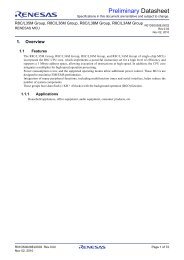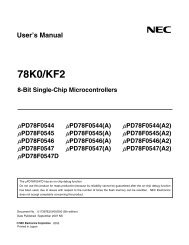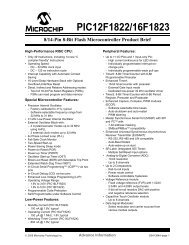xmega a3u - Elfa
xmega a3u - Elfa
xmega a3u - Elfa
Create successful ePaper yourself
Turn your PDF publications into a flip-book with our unique Google optimized e-Paper software.
XMEGA A3U<br />
6. AVR CPU<br />
6.1 Features<br />
• 8/16-bit, high-performance Atmel AVR RISC CPU<br />
– 142 instructions<br />
– Hardware multiplier<br />
• 32x8-bit registers directly connected to the ALU<br />
• Stack in RAM<br />
• Stack pointer accessible in I/O memory space<br />
• Direct addressing of up to 16MB of program memory and 16MB of data memory<br />
• True 16/24-bit access to 16/24-bit I/O registers<br />
• Efficient support for 8-, 16-, and 32-bit arithmetic<br />
• Configuration change protection of system-critical features<br />
6.2 Overview<br />
6.3 Architectural Overview<br />
All Atmel AVR XMEGA devices use the 8/16-bit AVR CPU. The main function of the CPU is to<br />
execute the code and perform all calculations. The CPU is able to access memories, perform<br />
calculations, control peripherals, and execute the program in the flash memory. Interrupt handling<br />
is described in a separate section, refer to ”Interrupts and Programmable Multilevel<br />
Interrupt Controller” on page 28.<br />
In order to maximize performance and parallelism, the AVR CPU uses a Harvard architecture<br />
with separate memories and buses for program and data. Instructions in the program memory<br />
are executed with single-level pipelining. While one instruction is being executed, the next<br />
instruction is pre-fetched from the program memory. This enables instructions to be executed on<br />
every clock cycle. For details of all AVR instructions, refer to http://www.atmel.com/avr.<br />
Figure 6-1.<br />
Block diagram of the AVR CPU architecture.<br />
8386B–AVR–12/11<br />
7
















